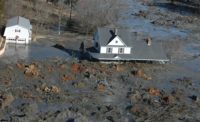Legal
TVA Cleanup Pact Cancels Coal-Ash Case Going to Supreme Court
Two environmental groups on Sept. 4 asked the U.S. Supreme Court to dismiss a petition they filed that sought cleanup of coal ash ponds at a Tennessee power plant, after the Tennessee Valley Authority agreed—as part of a related state court settlement—to close unlined pits and remove combustion residue that was contaminating drinking-water sources and waterways through groundwater.
That action removes one of several closely watched lower-court cases that are set for a high court decision, possibly by year end, on whether discharges to groundwater, such as those from the ponds, could be regulated as "point sources" of pollution under the federal Clean Water Act.
Appellate courts have issued recent conflicting interpretations on the issue, which prompted the high court review.
Goal Achieved
The Tennessee Clean Water Network and Tennessee Scenic Rivers Association withdrew their Supreme Court petition after TVA settled a state court lawsuit filed by the Tennessee Dept. of Environment and Conservation for the cleanup. As a result, the groups said, they “have achieved the principal goals they sought through this Clean Water Act suit.”
Under the pact, TVA agreed to remove 12 million tons of coal ash from active ponds at the Gallatin plant located on the Cumberland River. The residue will either be placed in lined permitted landfills or recycled as concrete or other construction material.
The estimated cost of the cleanup is $650 million, TVA said.
The federal power producer also agreed to identify the extent of soil, surface and groundwater contamination at the plant and evaluate remedial measures to address the contamination.
TVA must submit a cleanup plan by Sept. 30, 2020 and complete closure of the ash pond complex within 20 years of the approval of the final plan.
TVA said the settlement to remove the coal ash to an onsite landfill and possibly for material recycling is the best option given complex geology and groundwater flows at the site.
Legal Battle
Tennessee filed its suit over the coal ash contamination in 2015 and the conservation groups intervened in federal court. A federal district court found that TVA was violating the Clean Water Act and ordered it to excavate the coal ash.
On appeal, the Sixth Circuit U.S. appellate court in Cincinnati agreed that the lower court rightly concluded that “an unlined ash waste pond in karst terrain immediately adjacent to a river that leaks pollutants into the groundwater is a major environmental problem,” but it vacated the cleanup requirement, saying the Clean Water Act never applies to any pollutant that travels from a point source through groundwater before polluting navigable waters.
The appellate court ruled that utilities in Tennessee and Kentucky did not violate the Act when contaminants in coal ash ponds at their facilities leached into the local groundwater.
In a pair of opinions, a three-judge appellate panel ruled that ash ponds are not “point sources” of pollution under that law, and that its language “excludes the migration of pollutants through groundwater.”
The environmental groups petitioned the Supreme Court to review the decisions.
Rulings last year by appeals courts in San Francisco (Ninth Circuit) and Atlanta (Fourth Circuit) differed from the Cincinnati decision, with the High Court now to decide whether the federal Act governs pollutants from a point source that are conveyed to navigable waters by a nonpoint source such as groundwater.
Oral arguments in the review are set to start on Nov. 6, but pressure is building to resolve the Ninth Circuit dispute that was a major catalyst for the Supreme Court taking the case.
A key government body in Maui County, Hawaii, which sought the High Court review, on Sept. 6 voted for a settlement between municipal officials and environmental groups over the use of injection wells for wastewater treatment, says Maui News. If the measure is approved by top officials, this case also would be pulled from the Supreme Court review.
As part of the decision-making, observers also are watching how the Court weighs changed U.S. Environmental Protection Agency guidance, issued in April, that says the federal clean-water law does not cover discharges to groundwater.
"The high court’s decision here, due either in late 2019 or early 2020, will likely inform the ongoing litigation and debate over the administration’s broader effort to regulatorily redefine the waters of the United States subject to Clean Water Act jurisdiction," say attorneys Bernadette M. Rappold and Candace H. Uduebor of Greenberg Traurig in a Sept. 1 opinion in the Denver Business Journal.
"Given the broad repercussions for the environment and the economy, regulators, regulated entities, and the public will continue to watch this space closely for new developments."




